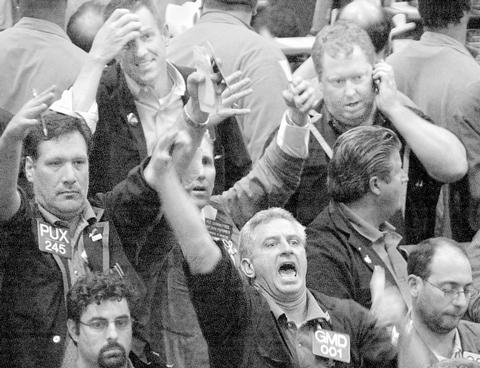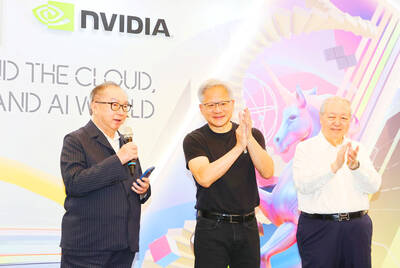Chicago Board of Trade membership prices fell to a 16-year low as a plunge in activity on a sister exchange cut demand for seats that confer trading privileges in both markets.
A full membership at the 154-year-old Board of Trade, which permits trading in all of the exchange's financial and grain contracts, sold for US$241,000 on Wednesday, down 46 percent in the past three months, exchange figures showed. It was the lowest price paid for a seat since May 1986, a spokeswoman said.

PHOTO: AP
The slump in prices for board seats, which allow members to also trade at the Chicago Board Options Exchange, reflects a 26 percent decline in activity at the options exchange in April from a year earlier, analysts said.
Board seats are losing value because of weaker demand for stock options used to protect portfolios.
"The problems at the CBOE are having a major impact" on Chicago Board of Trade membership values, said Raymond Cahnman, a CBOT director who trades bond futures. "Our fortunes are tied together."
About 45 percent of CBOT seats are used to trade at the options exchange.
The Chicago Board of Trade, the second-largest US futures market, has been introducing new contracts, such as futures tied to interest-rate swaps, and investing in its electronic order-routing system to stem the flow of traders to the Chicago Mercantile Exchange and other derivatives markets.
Last month, the board lowered trading fees as much as 40 percent in its auction-style pits in a bid to boost activity and prop up membership prices, which have lost 72 percent of their value since reaching a record high of US$857,500 in September 1997.
The Board of Trade is home to futures and options linked to government debt, the Dow Jones Industrial Average index and farm commodities such as soybean and oats.
Seat prices are also down at the options exchange, falling 3.3 percent to US$192,500 yesterday from US$199,000 on May 3. CBOE memberships have lost 74 percent of their value since reaching a high of US$735,100 on Feb. 27, 1998, exchange figures showed.
Chicago Board of Trade members have had the right to buy and sell contracts at the options exchange since the CBOE was founded in 1973 by a group of Board of Trade members. The markets are connected by a glass-enclosed walkway across Van Buren Street in Chicago's Loop district.
"I have talked to the CBOE leadership and I know that the stock-market slowdown has seriously impacted their membership value," Board of Trade Chairman Nickolas Neubauer said in an April 24 address to board members.
About 630 of the board's 1,402 memberships are used to trade at the options exchange, Neubauer said. In December 2000, 700 CBOT memberships were used to access the options exchange.
Traders bought and sold 21.69 million contract on the options exchange in April, down from 29.45 million in April 2001, exchange figures showed. Average daily volume for the month fell 33 percent from a year earlier to 986,024 contracts from 1.47 million.
At the Board of Trade, trading volume rose 18 percent in April from a year earlier to 23.735 million contracts, the board said. For the first four months of the year, trading rose 15 percent from a year ago to 94.97 million contracts.
The Board of Trade, founded in 1848 to buy and sell wheat, corn and other agricultural commodities, was surpassed in 2001 as the busiest US futures market by the Chicago Mercantile Exchange, home to contracts linked to Eurodollars, the Standard & Poor's 500 index, livestock and milk.

AI SERVER DEMAND: ‘Overall industry demand continues to outpace supply and we are expanding capacity to meet it,’ the company’s chief executive officer said Hon Hai Precision Industry Co (鴻海精密) yesterday reported that net profit last quarter rose 27 percent from the same quarter last year on the back of demand for cloud services and high-performance computing products. Net profit surged to NT$44.36 billion (US$1.48 billion) from NT$35.04 billion a year earlier. On a quarterly basis, net profit grew 5 percent from NT$42.1 billion. Earnings per share expanded to NT$3.19 from NT$2.53 a year earlier and NT$3.03 in the first quarter. However, a sharp appreciation of the New Taiwan dollar since early May has weighed on the company’s performance, Hon Hai chief financial officer David Huang (黃德才)

The Taiwan Automation Intelligence and Robot Show, which is to be held from Wednesday to Saturday at the Taipei Nangang Exhibition Center, would showcase the latest in artificial intelligence (AI)-driven robotics and automation technologies, the organizer said yesterday. The event would highlight applications in smart manufacturing, as well as information and communications technology, the Taiwan Automation Intelligence and Robotics Association said. More than 1,000 companies are to display innovations in semiconductors, electromechanics, industrial automation and intelligent manufacturing, it said in a news release. Visitors can explore automated guided vehicles, 3D machine vision systems and AI-powered applications at the show, along

FORECAST: The greater computing power needed for emerging AI applications has driven higher demand for advanced semiconductors worldwide, TSMC said The government-supported Industrial Technology Research Institute (ITRI) has raised its forecast for this year’s growth in the output value of Taiwan’s semiconductor industry to above 22 percent on strong global demand for artificial intelligence (AI) applications. In its latest IEK Current Quarterly Model report, the institute said the local semiconductor industry would have output of NT$6.5 trillion (US$216.6 billion) this year, up 22.2 percent from a year earlier, an upward revision from a 19.1 percent increase estimate made in May. The strong showing of the local semiconductor industry largely reflected the stronger-than-expected performance of the integrated circuit (IC) manufacturing segment,

NVIDIA FACTOR: Shipments of AI servers powered by GB300 chips would undergo pilot runs this quarter, with small shipments possibly starting next quarter, it said Quanta Computer Inc (廣達), which supplies artificial intelligence (AI) servers powered by Nvidia Corp chips, yesterday said that AI servers are on track to account for 70 percent of its total server revenue this year, thanks to improved yield rates and a better learning curve for Nvidia’s GB300 chip-based servers. AI servers accounted for more than 60 percent of its total server revenue in the first half of this year, Quanta chief financial officer Elton Yang (楊俊烈) told an online conference. The company’s latest production learning curve of the AI servers powered by Nvidia’s GB200 chips has improved after overcoming key component